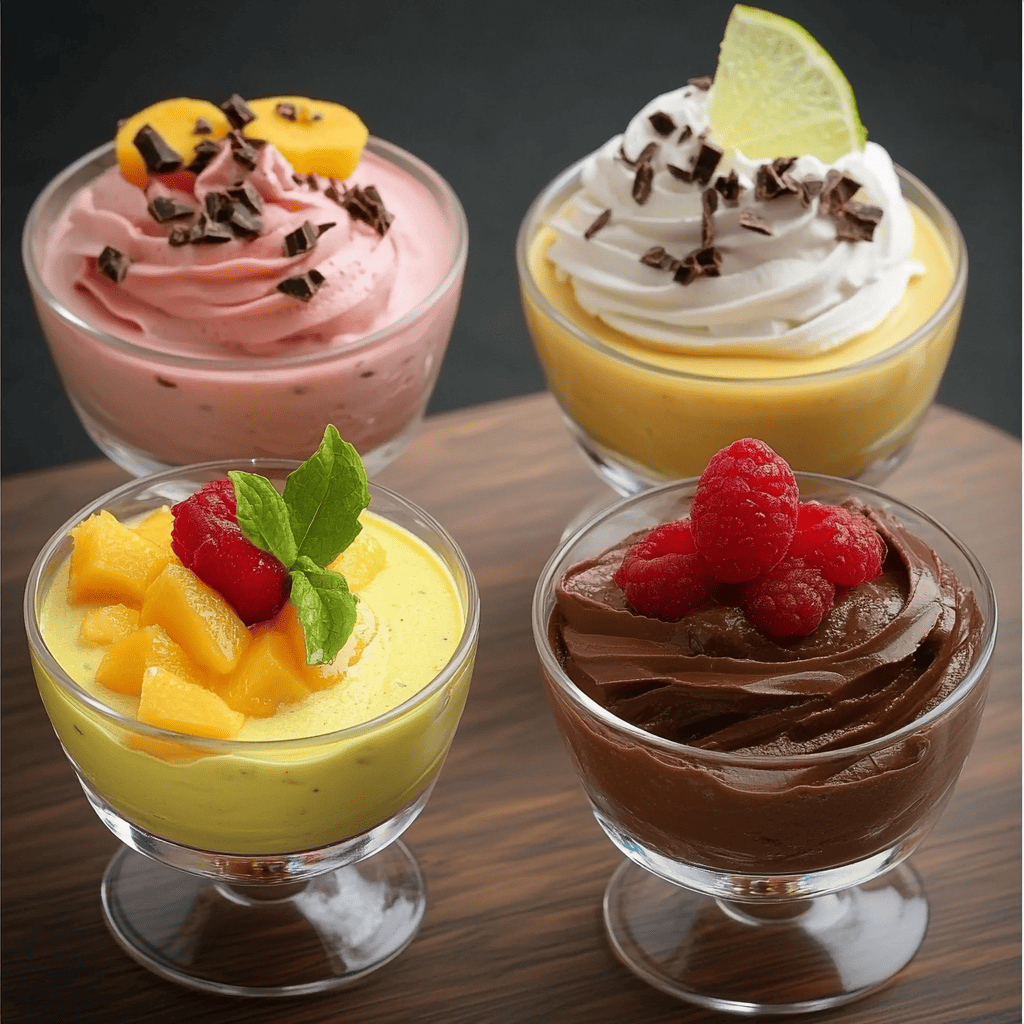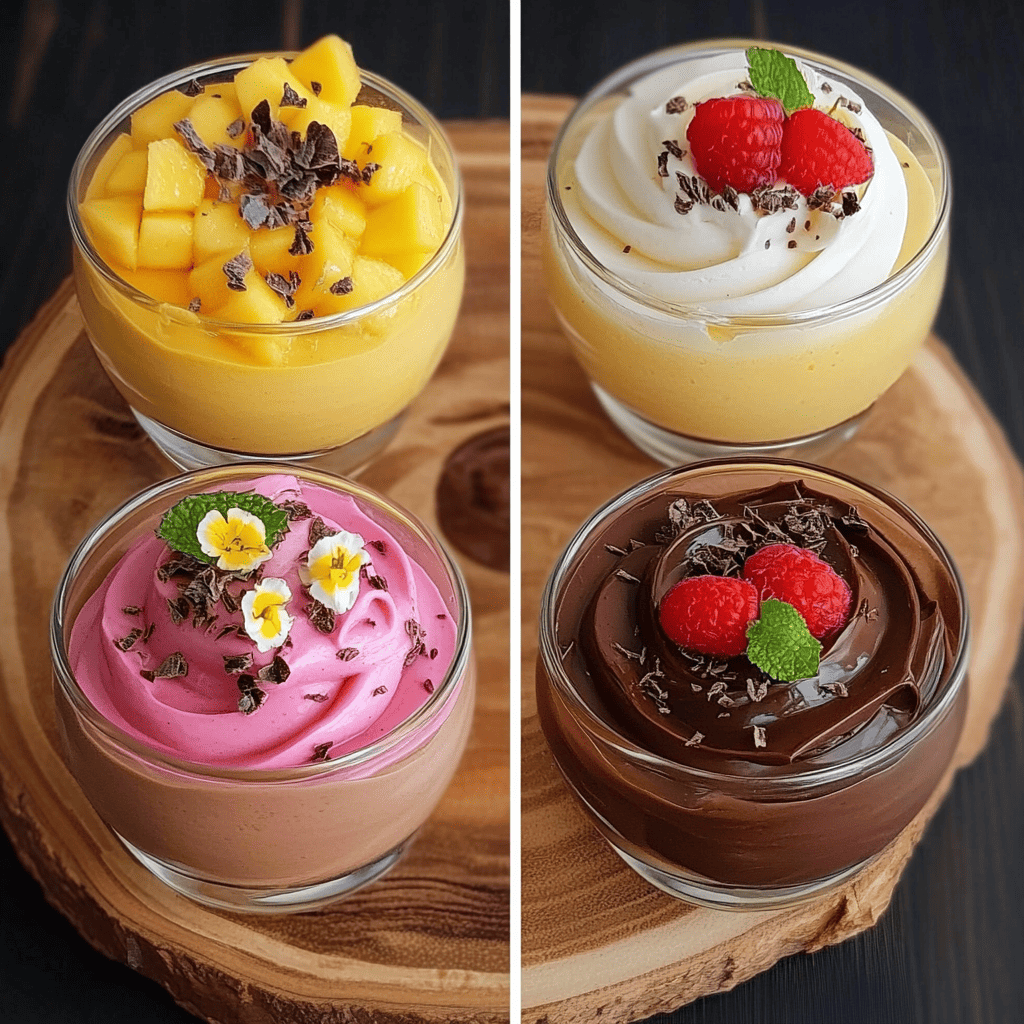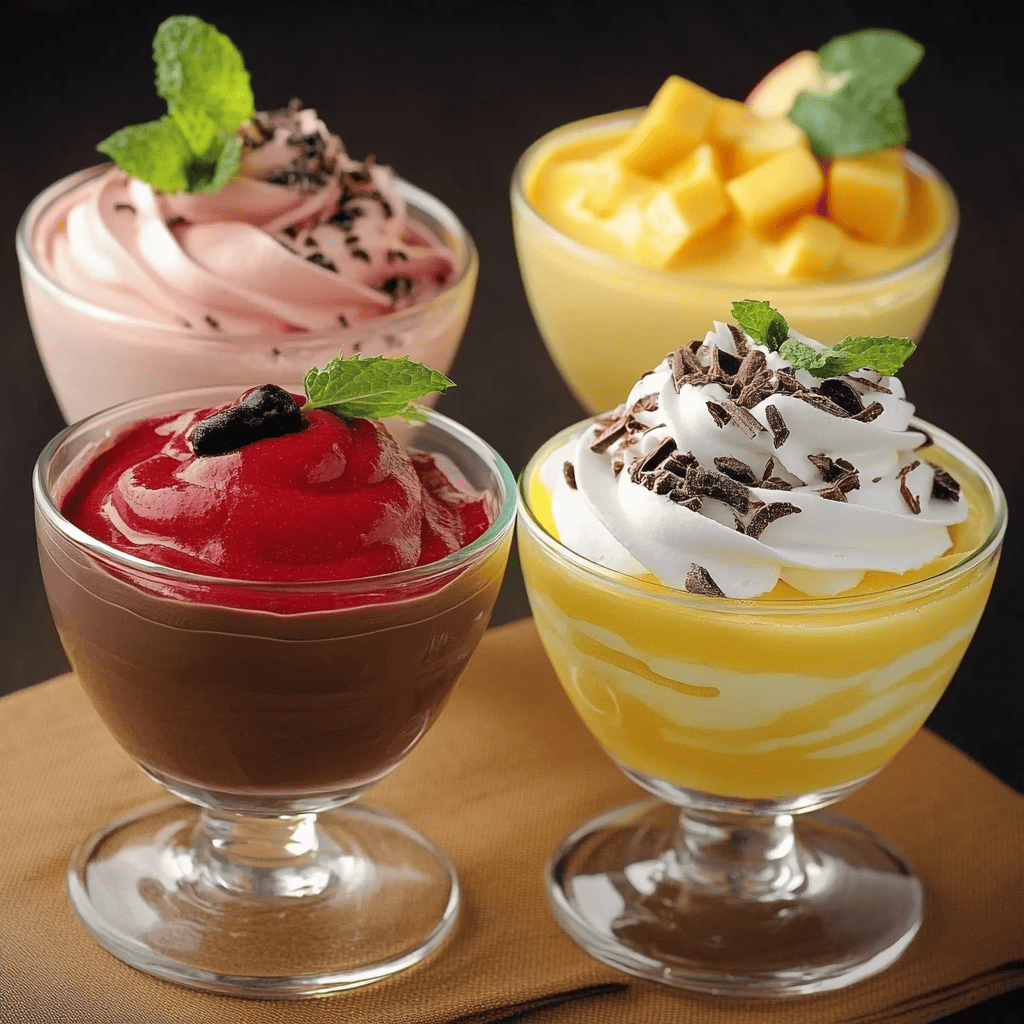Mousses: Symphony of Lightness and Flavor in Four Chapters
Introduction: The Art of Creamy Delicacy
Mousses, as seen in this appetizing image, are desserts that embody sophistication and lightness. Their name, which means “foam” in French, perfectly describes their characteristic airy and delicate texture that melts in the mouth. This collection of mousses (chocolate, mango, lemon, and strawberry) demonstrates the versatility of this dessert, capable of adapting to a wide range of flavors, from the intensity of cocoa to the freshness of citrus and tropical fruits. They are the perfect ending to any meal, or a delicious treat anytime. Discover all the secrets of these preparations that will delight you with their elegance, ease, and delicious results!
A Detailed History in Spanish: From French Cuisine to a Global Celebration of Lightness
The history of mousse is a fascinating journey that begins in sophisticated French gastronomy and extends to conquer palates around the world, adapting to diverse cultures and preferences.
French Origins and the 18th Century: The concept of a “foamy” or “airy” dish has roots in 18th-century French cuisine. While “chocolate mousse” is the most iconic, the earliest versions of mousse were not necessarily sweet. The first documented use of the word “mousse” in a culinary context is said to appear in a 1755 French cookbook, where it referred to foamy dishes, both sweet and savory. These early savory mousses were often made with fish or meat pounded to a thin consistency and served cold.
Sweet Mousse and the 19th Century: Chocolate as the Star: It wasn’t until the 19th century that sweet mousse began to gain prominence, with chocolate mousse becoming its most famous ambassador. Chocolate’s popularity in Europe grew exponentially, and French chefs, ever innovative, began experimenting with it. The addition of stiffly beaten egg whites (meringue) and whipped cream (crème whip) was key to achieving the characteristic airy texture we know today. Painter Henri de Toulouse-Lautrec (late 19th century) is often credited with inventing “Chocolate Mayonnaise,” which some consider a precursor to modern chocolate mousse.
International Expansion and the 20th Century: Throughout the 20th century, mousse transcended France and became popular in haute cuisine and homes around the world. Its lightness made it ideal as a dessert, especially after heavy meals. The availability of refrigeration and the greater accessibility of ingredients such as quality chocolate, cream, and tropical fruits facilitated its creation and experimentation. The mousse technique was applied to a multitude of flavors, giving rise to the fruit mousses (strawberry, mango, lemon) we see today.
Fruit Mousse: Adapting to Global Flavors: Fruit mousse emerged as a lighter, more refreshing alternative to chocolate mousse. By using fruit purees, condensed milk, cream, and often gelatin to stabilize the mixture, silky textures and vibrant flavors are achieved. The use of gelatin is particularly common in fruit mousses to ensure a good consistency without relying exclusively on egg whites or whipped cream. Mangoes, with their tropical sweetness, and strawberries, with their refreshing acidity, became popular choices, as did lemon, which adds a citrus acidity and a special brightness.
Mousse in the Modern Kitchen: Today, mousse is a versatile and beloved dessert, present in haute cuisine restaurants and home cookbooks. The simplicity of some of its versions (such as lemon mousse with only three ingredients) makes it accessible even for novice cooks, while other more elaborate recipes remain a challenge for experienced chefs. It represents a perfect balance between indulgence and lightness, which keeps it a timeless and popular dessert.
In short, mousse is a testament to French culinary creativity, which, over the centuries, has adapted and reinvented itself to meet the tastes and needs of a global audience, while always maintaining its essence as an airy and delicious dessert.
More Historical Detail: French Gastronomy and the Pleasure of Lightness
Delving a little deeper into the history and cultural relevance of mousses, we can highlight:
- The Legacy of French Haute Cuisine: Mousse is a reflection of the sophistication and attention to detail that characterize French haute cuisine. French chefs pioneered techniques to incorporate air into preparations, not only for mousse, but also for soufflés and sabayons, elevating food to an art form.
- Texture as a Central Element: Unlike many desserts that focus on richness or crunch, mousse prioritizes texture. “Lightness” and “creaminess” are its hallmarks, offering a unique sensory experience that melts in the mouth, leaving a lingering flavor without being overwhelming.
- The Evolution of Sweeteners and Dairy: The evolution of mousse is linked to the availability and lower cost of key ingredients. Condensed milk and evaporated milk, which are mainstays in some of these fruit mousse recipes, are products of the dairy industry of the 19th and 20th centuries, which made it easier to create creamy desserts without the need for fresh cream, which was more expensive and less accessible in certain places or times.
- Mousse as a “Culinary Canvas”: Mousse is, in essence, a blank canvas for a myriad of flavors. While the classics (chocolate, vanilla, coffee) are timeless, the addition of seasonal or exotic fruits (mango, strawberry, lemon, raspberry, passion fruit) demonstrates its incredible adaptability and how it can reflect the diversity of ingredients available around the world.
- Serving in Individual Glasses: Serving mousses in individual glasses, as shown in the image, is a common practice. This not only enhances their visual appeal (allowing you to see the layers and consistency) but also facilitates serving at gatherings and events, offering perfect portions and an elegant dining experience.
These mousses are more than just desserts; they’re a celebration of culinary creativity, textural engineering, and the harmony of flavors, which have endured over time thanks to their inherent appeal and versatility.

Ingredients & Detailed Preparation
1. Chocolate Mousse
Ingredients:
- Dark chocolate (minimum 70% cocoa): 200 g
- Large eggs (whites and yolks separated): 3 units
- Granulated sugar: ¼ cup (approximately 50 g)
- Whipping cream (milk cream, minimum 35% fat), very cold: 1 cup (approximately 240 ml)
- Pinch of salt:
Necessary equipment:
- 2 medium or large mixing bowls
- Small saucepan or double boiler for melting chocolate
- Electric or whisk mixer
- Rubber spatula
- Individual glasses or a large serving bowl
Detailed Preparation:
- Melt the chocolate: Chop the dark chocolate and melt it in a double boiler or microwave in short bursts, stirring every 30 seconds, until completely smooth. Let it cool slightly to room temperature. It’s crucial that it’s not hot when mixing.
- Beat the egg whites until stiff: In a clean, dry bowl, whisk the egg whites with a pinch of salt. Using an electric mixer, begin beating at medium speed until foamy. Gradually add the sugar while continuing to beat at high speed until you have a glossy, firm meringue that forms soft but stiff peaks.
- Whip the cream: In another chilled bowl, pour in the chilled whipping cream. Beat at high speed until stiff and soft peaks form. Be careful not to overbeat to prevent it from turning into butter.
- Prepare the chocolate base: In a bowl, combine the egg yolks with the melted, slightly cooled chocolate. Stir well until the mixture is smooth and evenly colored.
- Fold in the cream: Using a rubber spatula, gently fold the whipped cream into the chocolate and egg yolk mixture, using circular motions to keep the cream light. Do this in two or three additions until almost combined.
- Add the whipped egg whites: Finally, fold the whipped egg whites into the mixture, also using gentle, circular motions. It’s important to do this gently to retain the incorporated air, which gives the mousse its characteristic texture. Mix until no streaks of white remain, but without overbeating.
- Refrigerate: Divide the mousse into individual glasses or a large bowl. Refrigerate for at least 2-3 hours, or ideally overnight, to allow the mousse to set and reach the perfect consistency.
- Garnish (optional): Before serving, you can garnish with chocolate shavings, chocolate pieces, a little more whipped cream, or a mint leaf.
2. Mango Mousse
Ingredients:
- Ripe mangoes (peeled and chopped): 2 large pieces (approximately 400-500 g of pulp)
- Condensed milk: 1 can (approx. 397 g)
- Whipping cream (milk cream, minimum 35% fat), very cold: 1 cup (approximately 240 ml)
- Unflavored gelatin powder: 1 tablespoon (approx. 7 g)
- Cold water: ¼ cup (approximately 60 ml)
Necessary equipment:
- Blender or food processor
- 2 medium bowls
- Electric or whisk mixer
- Small saucepan or microwave (for gelatin)
- Rubber spatula
- Individual glasses or a large serving bowl
Detailed Preparation:
- Hydrate and dissolve the gelatin: In a small bowl, sprinkle the powdered gelatin over 1/4 cup of cold water. Let it sit for 5-10 minutes until it hydrates and becomes fluffy. Then, microwave the mixture for 10-15 seconds or use a double boiler until the gelatin is completely dissolved and no lumps remain. Let it cool slightly.
- Prepare the mango puree: In a blender or food processor, blend the peeled mango pieces until you have a smooth, lump-free puree. If the mangoes are very fibrous, you can strain them to ensure a silky texture.
- Whip the cream: In a chilled bowl, beat chilled whipping cream at high speed until stiff peaks form.
- Mix the mousse base: In another large bowl, combine the mango puree and condensed milk. Mix well until fully combined.
- Stir in the gelatin: Pour the dissolved and slightly cooled gelatin into the mango and condensed milk mixture. Stir quickly to combine evenly.
- Add the whipped cream: Using a rubber spatula, gently fold the whipped cream into the mango mixture, using circular motions. Do this in two or three additions to keep the mousse light.
- Refrigerate: Divide the mousse into individual glasses or a large bowl. Refrigerate for at least 4 hours, or until completely set and firm.
- Garnish (optional): Before serving, you can garnish with fresh mango chunks, a drizzle of chocolate syrup, or a mint leaf.
3. Lemon Mousse
Ingredients:
- Condensed milk: 1 can (approx. 397 g)
- Evaporated milk (refrigerated): 1 can (approx. 354 ml)
- Fresh lemon juice: ½ cup (approximately 120 ml)
- Lemon zest (optional, for flavor and decoration):
- Whipping cream (optional, for a lighter texture): ½ cup (approximately 120 ml)
Necessary equipment:
- Large mixing bowl
- Whisk or electric mixer
- Rubber spatula
- Individual glasses or a large serving bowl
Detailed Preparation:
- Chill the evaporated milk: Make sure the evaporated milk is very cold, as this helps thicken it when mixed with the lemon. If you don’t have it cold, refrigerate it for at least 30 minutes or freeze it for 15 minutes.
- Prepare the mousse base: In a large bowl, combine the condensed milk and evaporated milk. Beat with a whisk or electric mixer until well blended.
- Add the lemon juice: Pour the fresh lemon juice into the milk mixture while continuing to whisk. You’ll notice that the mixture will begin to thicken almost immediately due to the reaction of the lemon acid with the milk proteins. Continue whisking for a minute or two until the mixture is creamy and thick.
- Add lemon zest and/or cream (optional): If you want a more intense lemon flavor, add the lemon zest and mix. If you prefer an even more airy texture, in a separate bowl, whip the 1/2 cup of cream until stiff, then gently fold it into the lemon mixture.
- Refrigerate: Divide the mousse into individual glasses or a large bowl. Refrigerate for at least 3-4 hours, or until completely set and cold.
- Garnish (optional): Before serving, you can garnish with more lemon zest, thin lemon slices, or a mint leaf.
4. Strawberry Mousse
Ingredients:
- Fresh, clean, stemmed strawberries: 300 g
- Condensed milk: 1 can (approx. 397 g)
- Whipping cream (milk cream, minimum 35% fat), very cold: 1 cup (approximately 240 ml)
- Unflavored gelatin powder: 1 tablespoon (approx. 7 g)
- Cold water: ¼ cup (approximately 60 ml)
Necessary equipment:
- Blender or food processor
- 2 medium bowls
- Electric or whisk mixer
- Small saucepan or microwave (for gelatin)
- Rubber spatula
- Individual glasses or a large serving bowl
Detailed Preparation:
- Hydrate and dissolve the gelatin: In a small bowl, sprinkle the powdered gelatin over 1/4 cup of cold water. Let it sit for 5-10 minutes until it hydrates and becomes fluffy. Then, microwave the mixture for 10-15 seconds or use a double boiler until the gelatin is completely dissolved and no lumps remain. Let it cool slightly.
- Prepare the strawberry puree: In a blender or food processor, blend the clean strawberries until you have a smooth puree. If you prefer a seedless texture, you can strain the puree through a sieve.
- Whip the cream: In a chilled bowl, beat chilled whipping cream at high speed until stiff peaks form.
- Mix the mousse base: In another large bowl, combine the strawberry puree and condensed milk. Mix well until fully combined.
- Stir in the gelatin: Pour the dissolved and slightly cooled gelatin into the strawberry and condensed milk mixture. Stir quickly to combine evenly.
- Add the whipped cream: Using a rubber spatula, gently fold the whipped cream into the strawberry mixture, using circular motions. Do this in two or three additions to keep the mousse light.
- Refrigerate: Divide the mousse into individual glasses or a large bowl. Refrigerate for at least 4 hours, or until completely set and firm.
- Garnish (optional): Before serving, you can garnish with fresh strawberries, a drizzle of strawberry syrup, or whipped cream.
Estimated Preparation Time
- Chocolate Mousse:
- Active preparation: 20-25 minutes
- Cooling: 2-3 hours (ideally 4 hours or more)
- Total time: Approximately 2.5 – 3.5 hours
- Mango/Strawberry Mousse:
- Active preparation: 15-20 minutes
- Cooling: 4 hours (minimum)
- Total time: Approximately 4 hours and 15-20 minutes
- Lemon Mousse:
- Active preparation: 10-15 minutes
- Cooling: 3-4 hours
- Total time: Approximately 3 hours and 10-15 minutes
Additional Tips
- Ingredients Temperature: For chocolate mousse, make sure the melted chocolate is cold before mixing it with the egg yolks to avoid cooking the eggs. For all mousses that use whipped cream, it’s crucial that the cream is very cold for it to whip properly.
- Folding movements: When incorporating egg whites or whipped cream, always use gentle, folding movements to avoid losing air and maintain the lightness of the mousse.
- Chocolate quality: For the chocolate mousse, use a good quality chocolate, as it is the main ingredient and its flavor will be the star.
- Fruit ripeness: For mango and strawberry mousses, use very ripe fruit to ensure maximum sweetness and flavor.
- Gelatin: Make sure the gelatin is completely dissolved and smooth before adding it to the mixture. If it’s hot, let it cool slightly so it doesn’t cook the other ingredients.
- Lemon Mousse Consistency: Lemon mousse thickens due to the reaction of citric acid with the proteins in condensed and evaporated milk. If you want a firmer texture, you can add half a teaspoon of dissolved gelatin.

Frequently Asked Questions
- Can I prepare the mousses in advance? Yes, mousses are ideal for preparing in advance, as they need refrigeration time to set. You can prepare them the day before.
- Can mousses be frozen? Yes, they can be frozen, although the texture may become a little more crystalline upon thawing, especially fruit mousses. Chocolate mousse generally freezes best. Thaw slowly in the refrigerator.
- What can I use for decoration? The options are endless: chocolate shavings, cocoa powder, fresh fruit, mint leaves, citrus zest, fruit or chocolate syrup, or a little extra whipped cream.
- Can I use substitutes for cream or condensed milk? For vegan alternatives, you can use coconut cream or vegetable whipping cream. For condensed milk, vegan versions are available. However, the texture and flavor may vary slightly.
- How do I know if the cream is whipped properly? It should form soft peaks and hold its shape. If you whip it too much, it will become grainy and turn into butter.
Texture and Flavor
All mousses share a fundamentally airy, light and smooth texture that melts in the mouth, but with different nuances:
- Chocolate Mousse: Rich, creamy and dense, yet airy and light, with an intense bittersweet chocolate flavor.
- Mango Mousse: Silky and very creamy, with the freshness and tropical sweetness of mango.
- Lemon Mousse: Extremely light, refreshing, and with a touch of acidity that awakens the palate. Condensed milk adds sweetness and creaminess.
- Strawberry Mousse: Smooth, creamy and slightly tart, with the vibrant, sweet flavor of fresh strawberries.
As for flavor , each mousse offers a unique experience:
- Chocolate: Deep and slightly bitter, with sweet notes and the classic comfort of cocoa.
- Mango: Sweet and exotic, with a slight acidic touch that makes it very refreshing.
- Lemon: Bright, citrusy and tangy, with a perfect balance of acidity and sweetness.
- Strawberry: Sweet and fruity, with the characteristic freshness of strawberries, evoking summer.
Consumer Context
Mousses are incredibly versatile desserts, ideal for:
- Dessert at elegant dinners: Their presentation in individual glasses makes them perfect for impressing guests.
- Celebrations and parties: Easy to prepare in large quantities and serve.
- Snacks or treats: Light and refreshing to enjoy at any time of day.
- Casual Dining: A sweet and sophisticated ending to a family meal.
- Themed events: A mango mousse for a tropical party, or a chocolate mousse for a more formal event.
Visual Aspect
The image features a collage of four different mousses, each in a stemmed glass, on a light wood board and a dark background.
- Chocolate Mousse: Dark brown and shiny, topped with a dollop of white whipped cream, a drizzle of chocolate syrup, and dark chocolate chunks. A fresh mint leaf adds a touch of green color.
- Mango Mousse: Vibrant yellow, with a generous dollop of white whipped cream. A drizzle of chocolate syrup and fresh mango chunks on top add contrast and color. Also featured is a mint leaf.
- Lemon Mousse: Pale yellow and creamy, with a tall top of toasted meringue (or whipped cream with lemon zest), decorated with lemon zest and a lemon slice. A fresh mint leaf completes the decoration.
- Strawberry Mousse: Pale pink and soft, with a crest of whipped cream. Garnished with strawberry syrup or mixed berries, a whole fresh strawberry on top, and a mint leaf.
Overall, the image is very attractive and appetizing, showing the variety of colors and textures, and suggesting the lightness and freshness of these desserts.
Curiosities
- “Mousse au Chocolat”: It is one of the most famous French desserts and has been part of French gastronomy for centuries.
- Gelatin in mousse: Although traditional chocolate mousses can set without gelatin (thanks to the fat in the chocolate and the air in the egg whites and cream), fruit mousses often benefit from gelatin to ensure a firm, stable texture.
- Egg-free variations: There are versions of mousse that do not contain eggs, using only whipped cream and a thickening agent (such as gelatin or chocolate).
- Savory mousse: Although less common today, savory mousses (salmon, liver, cheese) are still prepared as appetizers or light starters.
Nutritional Value (Estimated per Serving)
Values vary greatly depending on the serving size and exact ingredients. Below is a general estimate per single serving (approximately 150-200g).
- Chocolate Mousse:
- Calories: 350-500 kcal
- Fat: 25-40 g (from chocolate and cream)
- Carbohydrates: 25-40 g (from chocolate and sugar)
- Protein: 5-8 g
- Mango/Strawberry Mousse (with condensed milk and cream):
- Calories: 300-450 kcal
- Fat: 18-30 g (from cream and condensed milk)
- Carbohydrates: 35-50 g (of fruit and condensed milk)
- Protein: 4-7 g
- Lemon Mousse (with condensed and evaporated milk):
- Calories: 250-400 kcal
- Fats: 10-20 g (from milk and cream optional)
- Carbohydrates: 40-60 g (from milk and juice)
- Protein: 7-10 g
Additional Benefits and Interesting Facts
- No-bake: Most mousses don’t require oven baking, making them perfect for quick desserts and warmer climates.
- Unlimited Creativity: The mousse base is so versatile that you can create endless combinations of flavors and textures.
- Presentation: They are always a success at the table due to their elegant appearance and vibrant colors.
- Perceived lightness: Despite its creaminess, the airy nature of the mousse makes it feel light and not heavy after a meal.
Other Information
- Variety of chocolates: In chocolate mousse, you can experiment with different percentages of cocoa to adjust the intensity of the flavor.
- Tropical touch: In mango and strawberry mousses, you can add a touch of liquor (such as rum or fruit liqueur) to intensify the flavor.
- Lemon Variations: For lemon mousse, you can use limes or even oranges for a citrusy variation.

Conclusion: The Delight of Lightness and Flavor
Mousses are a dessert that transcends the merely culinary to become a complete sensorial experience. Their lightness, creaminess, and the explosion of flavors offered in every spoonful make them irresistible. Whether classic chocolate, the tropical sweetness of mango, the citrusy freshness of lemon, or the liveliness of strawberry, each mousse is an edible work of art that promises a sweet and memorable ending to any occasion. They are the perfect example of how simplicity and technique can combine to create something truly extraordinary. Go ahead and prepare them and enjoy the magic of mousses!

